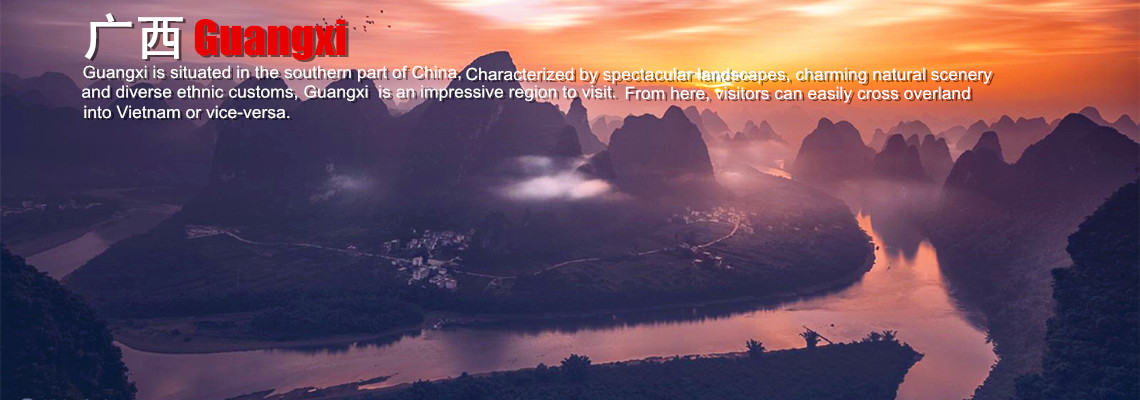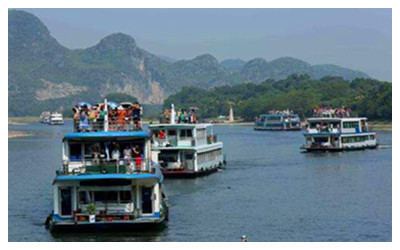Skype: neodalle-travel
Tel: +86 135 7447 2266
E-mail: sales@visitaroundchina.com

Guangxi Zhuang Autonomous Region, called "Gui" for short, has a long history over 2,000 years. Guangxi boasts fantastic and varied natural scenery (stunning karst hills and caves, larger forested mountains, crystal clear rivers, waterfalls and sunny beaches) and a wealth of minority culture. Being famous for Guilin, Guangxi is one of the most popular destions of China.
Facts of Guangxi
Chinese Name: 广西 (Guǎng Xī)
Abbreviation: Gui 桂
Administration Type: Autonomous Region
Capital: Nanning
Location: 20°54' to 26°24' N, 104°26' to 112°04' E
Climte: tropical/ subtropical monsoon climate
Area: 236,700 km² (91,390mi²)
Population (2010): 46026629
Nationalities: Zhuang,Yao,Miao,Dong
Administrative Division: Guangxi is divided into fourteen prefecture-level cities, fifty-six counties, thirty-four districts, twelve ethnic autonomous counties and seven county-level cities.
History of Guangxi
Although a remote province of China, Guangxi is not less important than others. With the past several thousand years, Guangxi has been important in the history of China. Initially the land of conquest for emperors, then land retirement for minorities persecuted by Northern ethnic groups, Guangxi had been the seat of the Taiping rebellion, which was rife in China for more than 20 years.Today, although bordering the wealthy province of Guangdong, Guangxi survives only thanks to the natural resources and the influx in tourism. It is easy to understand when you see the beautiful, natural landscape and its cultural heritage why this place is so fascinating to visitors.
Geography of Guangxi
Guangxi is the only province in West China that both an international border and a sea coast, serving as a juncition with the Beibu Gulf economical zone circle and the ASEAN Economic Circle, thus the reason Nanning was chosen as the permanent host city for China- ASEAN Expo.
Guangxi is a mountainous region. The Nanling Mountains are found in the northeast border, with the Yuecheng Mountains and Haiyang Mountains being its shorter branching ridges. To the north there are the Duyao Mountains and the Fenghuang Mountains, while on the southeast border there is the Yunkai Mountain. The highest point is Mount Maoer located in the Yuecheng Mountains, at 2141 m.
Population of Guangxi
At the end of 20016, Guangxi's population is 52.61 million, the population density is 208 every square kilometer. The region is inhabited majorly by 12 different groups, namely, Zhuang, Han, Yao, Miao, Dong, Mulao, Maonan, Hui, Jing, Yi, Shui and Gelao. The Zhuang nationality is taking up 1/3 of the total population.
In Guangxi, almost 40% of the population belongs to one of the 55 ethnic minorities in China. As its name suggests, Zhuang autonomous region, the majority ethnic group in Guizhou is Zhuang. Most of them, though widely Sinicize, live in the south-west of the region, between Nanning and Vietnam.
The rest of the ethnic groups mainly settled in northern Guangxi. There, we find a profusion of small ethnic villages of Yi, Miao, Dong, Mulao, Maonan or Hui Jing, Sui and Gelao. Thus, over 15 million of the Zhuang people and nearly 3 million members of other minorities that populate Guangxi, each bringing their language, architecture, customs, clothing add to the regions charm.
Guangxi Tourism
 Landscapes formed by karst peaks reflected on the Li River, terraced fields and small minority villages, are presented in the Guangxi travel guide. The main sites to admire in this province are the most beautiful and typical karst landscapes of China. Guangxi has had an extensive history which incorporates the past tumultuous dozens of ethnic groups are left for too long in the shadows. This mountainous region is in contrast to the developed Guangdong region nearby.
Landscapes formed by karst peaks reflected on the Li River, terraced fields and small minority villages, are presented in the Guangxi travel guide. The main sites to admire in this province are the most beautiful and typical karst landscapes of China. Guangxi has had an extensive history which incorporates the past tumultuous dozens of ethnic groups are left for too long in the shadows. This mountainous region is in contrast to the developed Guangdong region nearby.
If you are interested in seeing where these minority groups live and learning about their cultures along with the surrounding landscapes you should certainly visit Guangxi. It is in the north, the most mountainous region, which has the highest number of villages. Those that enjoy cycling can make a stop at some small authentic villages.
To visit the attractions of Guangxi, it is the best to take the Li River cruise to admire the remarkable landscapes formed by karst peaks between Guilin and Yangshuo. In the North of Guilin, Longsheng is also a must-see destination with its rice terraces. For the adventurous, continue the trip to Guizhou through Sanjiang.
In the southern part of the province, less crowded, impressive waterfalls of Detian, Huashan rock paintings and the most beautiful beaches in China are worth a visit.
 Ask Questions ?
Ask Questions ?